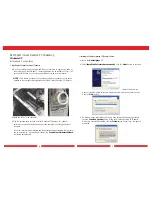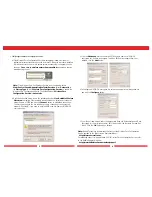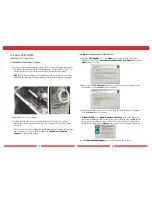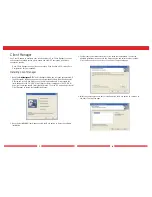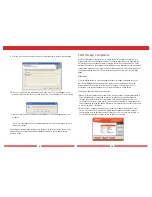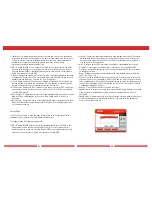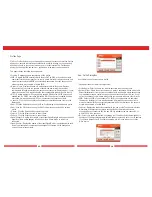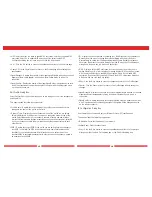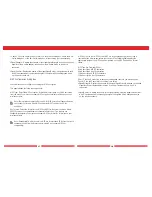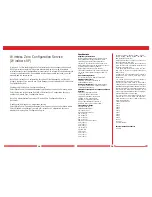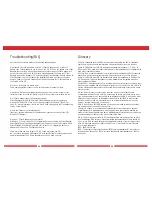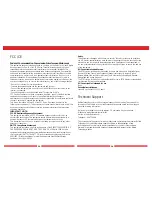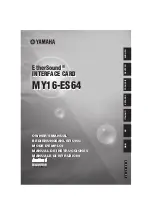
21
22
Troubleshooting/FAQ
Use this section to locate answers to frequently asked questions.
What should I do if I already have a version of Client Manager on my notebook?
Update your Client Manager to the version on the CD. If you do not update your Client
Manager, there could be a loss of functionality, as some versions of Client Manager will
not work properly with the G54 Wireless Notebook Adapter.To update your Client
Manager, load the Air Navigator CD and select Install Client Manager. If an old version of
Client Manager is on your notebook, the InstallShield Wizard prompts you to select
Remove, Repair, or Cancel Operation. Select Repair to update your Client Manager to
the version on the CD.
Why won't all my network clients work?
Some operating systems support only a limited number of network clients.
Windows 98/Me:These operating systems support only four network clients. If you
install more than four network clients, only the first four clients you install will work.
Will Client Manager support all operating systems?
Client Manager and the G54 Wireless Notebook Adapter currently support only
Windows 98/ME/2000/XP.They do not currently support Windows NT, Mac OS, or
Linux. For more information, refer to the Mac OS and Linux page in the Troubleshooting
section of this help file.
Where can I attach my external antenna?
Insert your external antenna into the antenna slot, located on the back of the G54
Wireless PCI Adapter.
Why won't Client Manager function properly?
Windows XP—The Wireless Zero Configuration Service conflicts with Client Manager.
Select Start»Control Panel»Administrative Tools»Services to open the Services window.
Select Disabled in the Startup Type field of Wireless Zero Configuration Service to
disable the Wireless Zero Configuration Service.
I have more than one Air Navigator CD. Do I need more than one CD?
No.You receive the same Air Navagator CD with each Buffalo Technology access point
and wireless adapter.The CDs are identical and you only need one copy.
Glossary
802.11b—Standards set by IEEE for wireless networking hardware. 802.11 standards
specify how wireless devices can interact with an access point or another wireless
device.WLANs that meet 802.11b standards can transmit at speeds of 1, 2, 5.5, or 11
Mbps in a 2.4 GHz band.All products that adhere to these standards are compatible with
each other, regardless of brand.
802.11g—New proposed standards for wireless networking hardware. 802.11 standards
specify how wireless devices can interact with an access point or another wireless
device.WLANs that meet 802.11g standards can transmit at speeds up to 54 Mbps in a
2.4 GHz band.All products that adhere to these standards are compatible with each
other, regardless of brand.
Access Point—An access point (AP) is a hardware device or a computer's software that
acts as a communication hub.APs enable wireless devices to connect to wired LANs.APs
provide heightened wireless security and extend the physical range of service a wireless
user can access.
Ad-hoc Mode—Networks that function in ad-hoc mode consist of devices that
communicate with each other directly, without using an access point. Each device must
have a wireless adapter so it can connect as an independent WLAN.Ad-hoc mode is also
called peer-to-peer mode or an Independent Basis Service Set (IBSS). Networks that
function in ad-hoc mode are most useful when no wireless infrastructure previously
exists or external services are not required.
BSS—A Basic Service Set (BSS) consists of a wired network and wireless devices that
use an access point to connect to each other.
Channel—A channel is a communications path between two computers or devices.
Digital Signature—A digital signature is an encrypted code that uniquely identifes the
sender of electronically transmitted data.A digital signature functions as a security device
by authenticating the identity of the person sending the data.
DNS—The domain name system (DNS) translates domain names, also known as URLs,
into IP addresses. DNS servers create and maintain these associations.There should be
one or more DNS servers within close geographical proximity of your access provider.
ESS—An Extended Service Set (ESS) consists of two or more Basic Service Sets that
form a single subnetwork.
IBSS—See Ad-hoc Mode.
IEEE—The Institute of Electrical Engineers (IEEE) develops standards for the computer
and electronics industry.The IEEE is currently finalizing the draft standards for 802.11g
technology.


